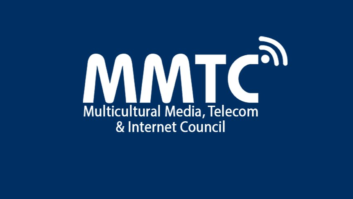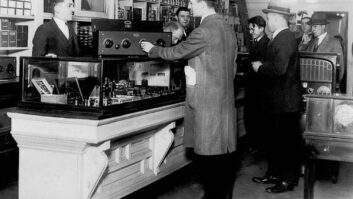(click thumbnail)Overview of IBOC Digital Radio SystemThis article will give the reader the nickel tour of the new “In-Band, On-Channel Digital Radio Broadcasting Standard” recently passed by members of the National Radio Systems Committee.
As a participant on the NRSC Digital Audio Broadcasting Subcommittee, I have my own opinions and business objectives. While this article is intended to be factual, please note that it contains my own interpretation, and is not the official word of the NRSC.
(click thumbnail)FM Band Implementation of NRSC-5 IBOC Digital Radio Standard
The role of a standard is to create a degree of market certainty for competitors to commit their resources to enter a market. A well-crafted standard may contain enough information that a person “skilled in the art” could use it as a recipe for producing a compatible product.
Even though the standard may outline the details necessary to understand and build on the technology on your own, it still may be necessary to license patents to build and sell your products. Standards bodies request that participants disclose their patents and make them available on reasonable and non-discriminatory, or so-called “RAND” terms.
The NRSC-5 standard was assembled under these precepts. It is significant that it is an IBOC standard rather than an HD Radio standard.
IBOC firmware/software
The term “IBOC” refers generically to the process of making the radio transmission, which also gives us the ability to receive and recover intelligence from the radio transmission. While, today, the only way to “do IBOC” is with devices that contain Ibiquity software/firmware that have earned the right to wear the HD Radio name, the standard provides enough information for a developer to implement the standard with his own firmware.
NRSC-5 is the fifth standard from the NRSC. It follows three AM broadcasting standards and the RDS standard.
Standards are voluntary, but they provide a roadmap for industry players to maintain compatibility among their products. They can also provide regulators with the much-needed industry consensus upon which to cast things in regulatory stone.
In the broadcasting arena, receiver compatibility with IBOC signals is critical to the success of the medium, and NRSC-5 describes for transmitter and receiver manufacturers how the IBOC signal is properly constructed.


NRSC-5 itself is a short 46-page document that contains an overview of the structure of IBOC transmission. As most standards do, NRSC-5 makes reference to more detailed documents called “normative references.”
These documents are frozen in time and contain the details of each portion of the AM and FM IBOC systems. So far, all normative references are versions of Ibiquity documents. Because the standard is subject to additions and revisions, there is always the possibility that future normative references could come not only from Ibiquity, but also from other sources.
Normative References For NRSC-51. Doc. No. SY_IDD_1011s rev. E, HD Radio Air Interface Design Description – Layer 1 FM, Ibiquity Digital Corp., 3/22/05
2. Doc. No. SY_IDD_1012s rev. E, HD Radio Air Interface Design Description – Layer 1 AM, Ibiquity Digital Corp., 3/22/05
3. Doc. No. SY_IDD_1014s rev. F, HD Radio Air Interface Design Description – Layer 2 Channel Multiplex Protocol, Ibiquity Digital Corp., 2/7/05
4. Doc. No. SY_IDD_1017s rev. E, HD Radio Air Interface Design Description – Audio Transport, Ibiquity Digital Corp.,3/31/05
5. Doc. No. SY_IDD_1020s rev. E, HD Radio Air Interface Design Description – Station Information Service Protocol, Ibiquity Digital Corp., 2/18/05
6. Doc. No. SY_SSS_1026s rev. D, HD Radio FM Transmission System Specifications, Ibiquity Digital Corp., 2/18/05
7. Doc. No. SY_IDD_1028s rev. C, HD Radio Air Interface Design Description – Main Program Service Data, Ibiquity Digital Corp., 3/31/05
8. Doc. No. SY_SSS_1082s rev. D, HD Radio AM Transmission System Specifications, Ibiquity Digital Corp., 2/24/05
9. Doc. No. SY_IDD_1085s rev. C, HD Radio Air Interface Design Description – Program Service Data Transport, Ibiquity Digital Corp., 2/7/05
The NRSC-5 standard organizes the system description into three functional groups, starting at the “bottom” with the group closest to the radio signal and ending with the group closest to the audio coder – the RF/transmission System, the Transport and Service Multiplex Subsystem, and the Audio and Data Input Subsystems. These systems form a protocol stack, a concept that may be familiar if you work with computer networking protocols.
The Open Systems Interconnection model is a generic model of the layering of protocols and serves as a good example of how protocols can be layered. For more details, Web search “open systems interconnection.”
The foundation of the protocol layers is the electrical signal running on its medium, whether it is, for instance, a radio signal propagating through space or an electrical signal on an Ethernet cable. This is the “physical layer” of the protocol stack.
IBOC’s physical layer consists of the Orthogonal Frequency Division Multiplexing radio frequency carriers that straddle the analog FM and AM signals. NRSC-5 gives an overview of the manner in which intelligence is impressed upon these carriers.
The RF/transmission System Characteristics section of NRSC-5 contains a subsection for AM and one for FM. These subsections give a general view of the processes that occur in this layer, which is called “Layer 1.”
Layer 1
Layer 1 takes information that has been organized for transport into “logical channels” and runs each logical channel through a scrambling process to randomize the ones and zeros of data bits to make the system more efficient. They are pseudo-randomized with a known procedure so they can be un-randomized at the receive end.
The logical channels are then run through a channel encoder, which should not be confused with an audio coder. The channel encoder adds data bits that are related to the incoming data stream in such a fashion that if some bits are lost or corrupted on the way to the receiver, there can be enough redundant information to recover them. This is the engine of the forward error correction system.
NRSC-5 then shows the interleaving process that spreads the data stream over the time of one frame of data, about a second and a half. This is to improve the chances of the data stream being recovered by FEC if it should get corrupted.
Finally NRSC-5 shows that Layer 1 maps the resulting scrambled, coded and interleaved frames of information to OFDM carriers in the radio spectrum. NRSC-5 lets the reference documents go into the complicated details such as what the scrambling algorithm is, what channel encoding is done to what channels, how the interleaver puts exactly the right bits in the right places in the frame, what OFDM carriers carry reference and synchronization information and what carriers handle the information frames, what the frequencies, power levels, modulation characteristics, and symbol rates of the OFDM carriers are, and so on.
See the list at the end of this article for normative references.
The RF/transmission System section of NRSC-5 also reproduces the Ibiquity-recommended spectrum masks.
Transport and Service Multiplex
NRSC-5 briefly mentions the functions of Layer 2 described in the normative reference document “Channel Multiplex.” This is a fairly thin layer that takes input from multiple sources and organizes it into the frames for each logical channel.
Layer 2 feeds its frames down to Layer 1. The multiple sources entering Layer 2 fall into several categories: the Main Program Service, Supplemental Program Service(s), Station Information Service and Advanced Data Services. These “services” are the protocols for presenting certain types of data streams to the IBOC system.
Audio and Data Transport
MPS consists of the Main Program Audio and any text carried along with it such as artist, title, etc. SIS carries data about the station and its digital signal to help the radio do its job. These two services are the core services because they are necessary for a basic IBOC radio to receive main channel programming.
MPS is the marriage of the MPA audio stream and the Main Program Service Data stream. NRSC-5 references the Program Service Data protocol document.
This describes how program-related data is formatted for the receiver to understand. For instance, if you want to send the artist’s name, this document explains how to format the information so the receiver will know it is the artist’s name.
Once formatted as MPSD, the data has to be joined with the audio stream by putting the data on a transport. NRSC-5 references a Program Service Data Transport document. This explains how to packetize and stream the MPSD to put it into the Audio Transport with the audio stream. Together, Audio Transport, the PSD protocol and the PSD Transport assemble the Main Program Service for handoff to Layer 2.
Supplemental Audio
Thanks to the work of National Public Radio in conjunction with Harris and Kenwood, with the support of Ibiquity, the concept of multi-channel transmission has made it to IBOC. NPR’s Tomorrow Radio project explored the potential for transmitting more than one channel of audio at once.
The idea is to make these Supplemental Audio Services as available to the public as main channel programming, giving listeners more variety on the radio. It should be relatively easy to add multiple channel capability to the design of even the least expensive IBOC receivers.
NRSC-5 makes an allowance for SAS on FM transmissions. Above Layer 2 supplemental audio is handled in the same fashion as main program audio. Supplemental audio and supplemental program service data use the same three protocols to be transported together: Audio Transport, PSD protocol and PSD Transport.
Advanced Data Service
NRSC-5 marks the Advanced Data Service protocol as “currently under review.” The standard was adopted only with the core elements intact. The ADS protocol will be the result of follow-on work by the NRSC.
ADS provides a way to transport data, whether or not related to a program audio stream, beyond the simple text format and low bit rate of PSD. Of course, an application using the Advanced Data Services protocol will be competing for bandwidth with program audio streams and other data services.
Stations will need to prioritize their use of their bandwidth to maximize its usefulness. Long-term lease agreements, common in the days of subcarrier services, should give way to short-term decisions on bandwidth allocation for maximum return. Stations can adjust their audio bit rates to balance the demand for a number of audio channels, their coding quality and the types, speed and reliability of any data services. But I digress; NRSC-5 merely holds a place for this protocol.
Audio codec
Having read this far, the reader may realize that the audio encoding and decoding algorithm is not mentioned in NRSC-5. Encoded audio is simply an input to the top of the IBOC stack and is not part of the NRSC-5 standard.
HD Radio products use the HD Codec to encode the audio for transmission and decode it for reception. Surely anyone planning to build a transmitter or radio will license the HDC codec for MPS in order to be compatible with the installed base in the marketplace. Those taking advantage of the Advanced Data Services protocol for transmitting audio files or streaming applications could use any codec of their choosing to make their applications work.
The new NRSC-5 IBOC standard is a relatively short document that glues together the normative references necessary to describe how to transmit a compatible IBOC signal. This article has summarized NRSC-5. For further information, including copies of the standard and the reference documents, check out the NRSC Web site: nrscstandards.org.












